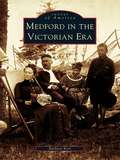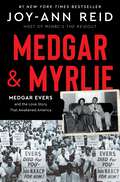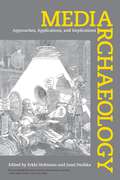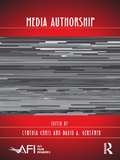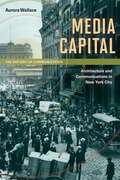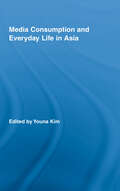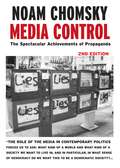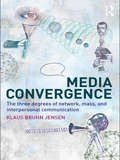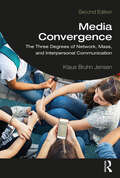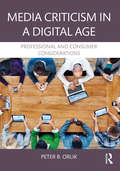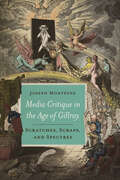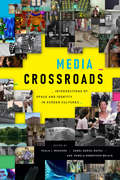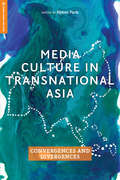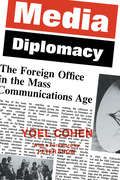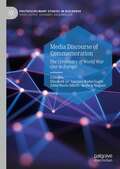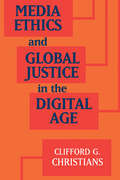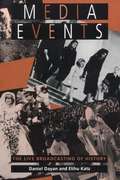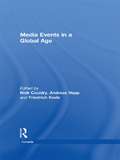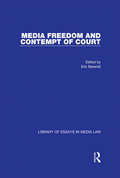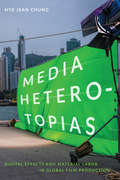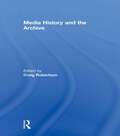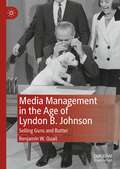- Table View
- List View
Medford in the Victorian Era (Images of America)
by Barbara KerrWhen the Boston and Lowell Railroad came through in 1835, Medford was a quiet town with fewer than two thousand residents. By the twentieth century, it had become a thriving city of eighteen thousand. In Victorian Medford, everything was new, from the Medford Opera House, the town hall, and the Mystic Lakes to the camera, the bicycle, and the gypsy moth. The shipbuilding, rum, and brickmaking industries gave way to new businesses, and traditional houses came to share neighborhoods with Queen Anne and Shingle-style architecture. In the mid-nineteenth century, there was great social change, as abolitionists Lydia Maria Child and George Luther Stearns spoke out against slavery and men went to the Civil War. James W. Tufts invented the soda fountain, Fannie Farmer wrote her first cookbook, and James Pierpont wrote "Jingle Bells."
Medford: A Brief History
by Dee MorrisSince its early days in the possession of a man who never set foot on the land itself, Medford has been a place of possibility. Many Medford residents have made their mark on American culture, including James W. Tufts, the inventor of the soda fountain, and Fannie Farmer, author of the first modern cookbook. Medford has been the site of revolutionary changes, as entrepreneur Thatcher Magoun built the wildly successful clipper ship industry, and in the case of Belinda Royall, a slave who remarkably won her legal emancipation in 1773. Author Dee Morris renders a richly detailed history, from the Medford Square rum distilleries that sent a molasses smell wafting through town for centuries to the celebration for Amelia Earhart, who lived in West Medford briefly, before her first successful transatlantic flight. Medford: A Brief History reveals hidden stories behind a small town with a big legacy.
Medgar and Myrlie: Medgar Evers and the Love Story That Awakened America
by Joy-Ann Reid#1 New York Times Bestseller“Medgar Evers deserves a place alongside Malcolm X and Dr. King in our historical memory. Evers, with Myrlie as his partner in activism and in life, was doing civil rights work in the single most hostile and dangerous environment in America.”—from Medgar and MyrlieBy MSNBC's Joy-Ann Reid, a triumphant work of biography that repositions slain Civil Rights pioneer Medgar Evers at the heart of America's struggle for freedom, and celebrates Myrlie Evers's extraordinary activism after her husband's assassination in the driveway of their Mississippi home."I love this book. The empathic, brilliant, and wise Joy Reid has brought us the poignant, fascinating inside story of Medgar and Myrlie Evers, transformational leaders who confronted pure evil and risked their lives to ensure that all American children might grow up in a United States that was more just. As Reid shows us, that painful task is now more urgent than ever.” — Michael BeschlossMyrlie Louise Beasley met Medgar Evers on her first day of college. They fell in love at first sight, married just one year later, and Myrlie left school to focus on their growing family.Medgar became the field secretary for the Mississippi branch of the NAACP, charged with beating back the most intractable and violent resistance to black voting rights in the country. Myrlie served as Medgar’s secretary and confidant, working hand in hand with him as they struggled against public accommodations and school segregation, lynching, violence, and sheer despair within their state’s “black belt.” They fought to desegregate the intractable University of Mississippi, organized picket lines and boycotts, despite repeated terroristic threats, including the 1962 firebombing of their home, where they lived with their three young children.On June 12, 1963, Medgar Evers became the highest profile victim of Klan-related assassination of a black civil rights leader at that time; gunned down in the couple’s driveway in Jackson. In the wake of his tragic death, Myrlie carried on their civil rights legacy; writing a book about Medgar’s fight, trying to win a congressional seat, and becoming a leader of the NAACP in her own right.In this groundbreaking and thrilling account of two heroes of the civil rights movement, Joy-Ann Reid uses Medgar and Myrlie’s relationship as a lens through which to explore the on-the-ground work that went into winning basic rights for Black Americans, and the repercussions that still resonate today.
Media Archaeology: Approaches, Applications, and Implications
by Erkki Huhtamo Jussi ParikkaThis book introduces an archaeological approach to the study of media - one that sifts through the evidence to learn how media were written about, used, designed, preserved, and sometimes discarded. Edited by Erkki Huhtamo and Jussi Parikka, with contributions from internationally prominent scholars from Europe, North America, and Japan, the essays help us understand how the media that predate today’s interactive, digital forms were in their time contested, adopted and embedded in the everyday. Providing a broad overview of the many historical and theoretical facets of Media Archaeology as an emerging field, the book encourages discussion by presenting a full range of different voices. By revisiting ‘old’ or even ‘dead’ media, it provides a richer horizon for understanding ‘new’ media in their complex and often contradictory roles in contemporary society and culture.
Media Authorship (AFI Film Readers)
by David A. Gerstner Cynthia ChrisContemporary media authorship is frequently collaborative, participatory, non-site specific, or quite simply goes unrecognized. In this volume, media and film scholars explore the theoretical debates around authorship, intention, and identity within the rapidly transforming and globalized culture industry of new media. Defining media broadly, across a range of creative artifacts and production cultures—from visual arts to videogames, from textiles to television—contributors consider authoring practices of artists, designers, do-it-yourselfers, media professionals, scholars, and others. Specifically, they ask: What constitutes "media" and "authorship" in a technologically converged, globally conglomerated, multiplatform environment for the production and distribution of content? What can we learn from cinematic and literary models of authorship—and critiques of those models—with regard to authorship not only in television and recorded music, but also interactive media such as videogames and the Internet? How do we conceive of authorship through practices in which users generate content collaboratively or via appropriation? What institutional prerogatives and legal debates around intellectual property rights, fair use, and copyright bear on concepts of authorship in "new media"? By addressing these issues, Media Authorship demonstrates that the concept of authorship as formulated in literary and film studies is reinvigorated, contested, remade—even, reauthored—by new practices in the digital media environment.
Media Capital: Architecture and Communications in New York City (The History of Communication)
by Aurora WallaceIn a declaration of the ascendance of the American media industry, nineteenth-century press barons in New York City helped to invent the skyscraper, a quintessentially American icon of progress and aspiration. Early newspaper buildings in the country's media capital were designed to communicate both commercial and civic ideals, provide public space and prescribe discourse, and speak to class and mass in equal measure. This book illustrates how the media have continued to use the city as a space in which to inscribe and assert their power. With a unique focus on corporate headquarters as embodiments of the values of the press and as signposts for understanding media culture, Media Capital demonstrates the mutually supporting relationship between the media and urban space. Aurora Wallace considers how architecture contributed to the power of the press, the nature of the reading public, the commercialization of media, and corporate branding in the media industry. Tracing the rise and concentration of the media industry in New York City from the mid-nineteenth century to the present, Wallace analyzes physical and discursive space, as well as labor, technology, and aesthetics, to understand the entwined development of the mass media and late capitalism.
Media Consumption and Everyday Life in Asia (Routledge Advances in Internationalizing Media Studies #Vol. 1)
by Youna KimThis book explores people’s everyday experience of the media in Asian countries in confrontation with huge social change and transition and the need to understand this phenomenon as it intersects with the media. It argues for the centrality of the media to Asian transformations in the era of globalization. The profusion of the media today, with new imaginations, new choices and contradictions, generates a critical condition for reflexivity engaging everyday people to have a resource for the learning of self, culture and society in a new light. Media culture is creating new connections, new desires and threats, and the identities of people are being reworked at individual, national, regional and global levels. Within historically specific social conditions and contexts of the everyday, the chapters seek to provide a diversity of experiences and understandings of the place of the media in different Asian locations. This book considers the emerging consequences of media consumption in people’s everyday life at a time when the political, socio-economic and cultural forces by which the media operate are rapidly globalizing in Asia.
Media Consumption and Everyday Life in Asia (Routledge Advances in Internationalizing Media Studies)
by Youna KimThis book explores people’s everyday experience of the media in Asian countries in confrontation with huge social change and transition and the need to understand this phenomenon as it intersects with the media. It argues for the centrality of the media to Asian transformations in the era of globalization. The profusion of the media today, with new imaginations, new choices and contradictions, generates a critical condition for reflexivity engaging everyday people to have a resource for the learning of self, culture and society in a new light. Media culture is creating new connections, new desires and threats, and the identities of people are being reworked at individual, national, regional and global levels. Within historically specific social conditions and contexts of the everyday, the chapters seek to provide a diversity of experiences and understandings of the place of the media in different Asian locations. This book considers the emerging consequences of media consumption in people’s everyday life at a time when the political, socio-economic and cultural forces by which the media operate are rapidly globalizing in Asia.
Media Control: The Spectacular Achievements of Propaganda (Open Media Series)
by Noam ChomskyNoam Chomsky's backpocket classic on wartime propaganda and opinion control begins by asserting two models of democracy--one in which the public actively participates, and one in which the public is manipulated and controlled. According to Chomsky, "propaganda is to democracy as the bludgeon is to a totalitarian state," and the mass media is the primary vehicle for delivering propaganda in the United States. From an examination of how Woodrow Wilson's Creel Commission "succeeded, within six months, in turning a pacifist population into a hysterical, war-mongering population," to Bush Sr.'s war on Iraq, Chomsky examines how the mass media and public relations industries have been used as propaganda to generate public support for going to war. Chomsky further touches on how the modern public relations industry has been influenced by Walter Lippmann's theory of "spectator democracy," in which the public is seen as a "bewildered herd" that needs to be directed, not empowered; and how the public relations industry in the United States focuses on "controlling the public mind," and not on informing it. Media Control is an invaluable primer on the secret workings of disinformation in democratic societies.
Media Convergence: The Three Degrees of Network, Mass and Interpersonal Communication
by Klaus Bruhn JensenThe development of digital media presents a unique opportunity to reconsider what communication is, and what individuals, groups, and societies might hope to accomplish through new as well as old media. At a time when digital media still provoke both utopian and dystopian views of their likely consequences, Klaus Bruhn Jensen places these ‘new’ media in a comparative perspective together with ‘old’ mass media and face-to-face communication, restating the two classic questions of media studies: what do media do to people, and what do people do with media? Media Convergence makes a distinction between three general types of media: the human body enabling communication in the flesh; the technically reproduced means of mass communication; and the digital technologies facilitating interaction one-to-one, one-to-many, as well as many-to-many. Features include: case studies, including mobile phones in everyday life, the Muhammad cartoons controversy and climate change as a global challenge for human communication and political action diagrams, figures, and tables summarizing key concepts beyond standard ‘models of communication’ systematic cross-referencing. Major terms are highlighted and cross-referenced throughout, with key concepts defined in margin notes.
Media Convergence: The Three Degrees of Network, Mass, and Interpersonal Communication
by Klaus Bruhn JensenThis second edition furthers conversations about the ongoing society-wide and worldwide digitalization of human communication. Reviewing the long lines in the history of media and communication – from writing via printing and broadcasting to computing – the book lays out three general types of media: the human body enabling face-to-face communication here and now; the technically reproduced means of mass communication across space and time; and the digital technologies integrating one-to-one, one-to-many, as well as many-to-many interactions. All these communicative practices coexist in contemporary media environments. Across cultures, genders, and age groups, people go on communicating in the flesh, via wires, and over the air, as illustrated though case studies of mobile communication on mundane matters, and of climate change as a global challenge for human communication and coexistence. The second edition includes: Updated accounts of research and public debate on digital media and communication Analyses of current social media and an emerging internet of things Systematic presentations of digital as well as traditional empirical methods Discussion of the normative implications of digitalization, including the classic rights of information and communication, and a right not to be communicated about through surveillance Interdisciplinary in scope to showcase the wide-reaching cultural consequences of media convergence, this book is ideal for advanced undergraduate students, graduate students, and scholars in the fields of media, communication, and cultural studies.
Media Criticism in a Digital Age: Professional And Consumer Considerations
by Peter B. OrlikMedia Criticism in a Digital Age introduces readers to a variety of critical approaches to audio and video discourse on radio, television and the Internet. It is intended for those preparing for electronic media careers as well as for anyone seeking to enhance their media literacy. This book takes the unequivocal view that the material heard and seen over digital media is worthy of serious consideration. Media Criticism in a Digital Age applies key aesthetic, sociological, philosophical, psychological, structural and economic principles to arrive at a comprehensive evaluation of programming and advertising content. It offers a rich blend of insights from both industry and academic authorities. These insights range from the observations of Plato and Aristotle to the research that motivates twenty-first century marketing and advertising. Key features of the book are comprised of: multiple video examples including commercials, cartoons and custom graphics to illustrate core critical concepts; chapters reflecting today’s media world, including coverage of broadband and social media issues; fifty perceptive critiques penned by a variety of widely respected media observers and; a supplementary website for professors that provides suggested exercises to accompany each chapter (www.routledge .com/cw/orlik) Media Criticism in a Digital Age equips emerging media professionals as well as perceptive consumers with the evaluative tools to maximize their media understanding and enjoyment.
Media Critique in the Age of Gillray: Scratches, Scraps, and Spectres
by Joseph MonteyneIn the late 1790s, British Prime Minister William Pitt created a crisis of representation when he pressured the British Parliament to relieve the Bank of England from its obligations to convert paper notes into coin. Paper quickly became associated with a form of limitless reproduction that threatened to dematerialize solid bodies and replace them with insubstantial shadows. Media Critique in the Age of Gillray centres on printed images and graphic satires which view paper as the foundation for the contemporary world. Through a focus on printed, visual imagery from practitioners such as James Gillray, William Blake, John Thomas Smith, and Henry Fuseli, the book addresses challenges posed by reproductive technologies to traditional concepts of subjective agency. Joseph Monteyne shows that the late eighteenth-century paper age’s baseless fabric set the stage for contemporary digital media’s weightless production. Engagingly written and abundantly illustrated, Media Critique in the Age of Gillray highlights the fact that graphic culture has been overlooked as an important sphere for the production of critical and self-reflective discourses around media transformations and the visual turn in British culture.
Media Crossroads: Intersections of Space and Identity in Screen Cultures
by Paula J. Massood, Angel Daniel Matos, and Pamela Robertson WojcikThe contributors to Media Crossroads examine space and place in media as they intersect with sexuality, race, ethnicity, age, class, and ability. Considering a wide range of film, television, video games, and other media, the authors show how spaces—from the large and fantastical to the intimate and virtual—are shaped by the social interactions and intersections staged within them. The highly teachable essays include analyses of media representations of urban life and gentrification, the ways video games allow users to adopt an experiential understanding of space, the intersection of the regulation of bodies and spaces, and how style and aesthetics can influence intersectional thinking. Whether interrogating the construction of Portland as a white utopia in Portlandia or the link between queerness and the spatial design and gaming mechanics in the Legend of Zelda video game series, the contributors deepen understanding of screen cultures in ways that redefine conversations around space studies in film and media.Contributors. Amy Corbin, Desirée J. Garcia, Joshua Glick, Noelle Griffis, Malini Guha, Ina Rae Hark, Peter C. Kunze, Paula J. Massood, Angel Daniel Matos, Nicole Erin Morse, Elizabeth Patton, Matthew Thomas Payne, Merrill Schleier, Jacqueline Sheean, Sarah Louise Smyth, Erica Stein, Kirsten Moana Thompson, John Vanderhoef, Pamela Robertson Wojcik
Media Culture in Transnational Asia: Convergences and Divergences (Global Media and Race)
by John Gagnon Hamid Abdollahyan Asantha U. Attanayake W. Michelle Wang Maya Dodd Hyesu Park Rea Amit Shubhda Arora Juhi Jotwani Dorothy Wai Lau Hiroki Yamamoto Sabiha Huq Darlene Machell Espena Alireza Dehghan Hoornaz KeshavarzianMedia Culture in Transnational Asia: Convergences and Divergences examines contemporary media use within Asia, where over half of the world’s population resides. The book addresses media use and practices by looking at the transnational exchanges of ideas, narratives, images, techniques, and values and how they influence media consumption and production throughout Asia, including: Sri Lanka, Bangladesh, South Korea, Singapore, Vietnam, Afghanistan, Iran and many others. The book’s contributors are especially interested in investigating media and their intersections with narrative, medium, technologies, and culture through the lenses that are particularly Asian by turning to Asian socio-political and cultural milieus as the meaningful interpretive framework to understand media. This timely and cutting-edge research is essential reading for those interested in transnational and global media studies.
Media Diplomacy: The Foreign Office in the Mass Communications Age
by Yoel CohenPublished in 1986, Media Diplomacy is a valuable contribution to the field of Military & Strategic Studies.
Media Discourse of Commemoration: The Centenary of World War One in Europe (Postdisciplinary Studies in Discourse)
by Hedwig Wagner Elisabeth Le Luciana Radut-Gaghi Alida Maria SillettiThis book explores how First World War commemoration events are presented, reported and mediated on the websites of mainstream daily newspapers from seven European countries. The book is the result of a research group – DIREPA-EUROPE (Discours, représentations, passé de l’Europe), part of Lemel research network – characterized by a shared interest in media discourse and online newspapers. It presents a fluid analysis chain on the commemoration discourse generated by the WWI Armistice Centenary in 2018, and will be of interest not only to scholars of discourse and media studies, but also of European history, cultural memory, journalism and conflict studies.
Media Ethics and Global Justice in the Digital Age (Communication, Society and Politics)
by Clifford G. ChristiansToday's digital revolution is a worldwide phenomenon, with profound and often differential implications for communities around the world and their relationships to one another. This book presents a new, explicitly international theory of media ethics, incorporating non-Western perspectives and drawing deeply on both moral philosophy and the philosophy of technology. Clifford Christians develops an ethics grounded in three principles - truth, human dignity, and non-violence - and shows how these principles can be applied across a wide range of cases and domains. The book is a guide for media professionals, scholars, and educators who are concerned with the global ramifications of new technologies and with creating a more just world.
Media Events
by Daniel DayanAn ethnography of how such media events as the Olympic Games, the moon landing, Kennedy's funeral, and the royal wedding, are scripted, negotiated, performed, celebrated, shamanized, and reviewed. Drawing from the theories of Max Weber and Emile Durkheim, shows how television can declare holidays and create history.
Media Events in a Global Age (Comedia)
by Andreas Hepp Nick Couldry Friedrich Krotz"This volume assembles an estimable range of critical analyses of one of the most important mediated artifacts of the modern world—the media event. The authors challenge the construct, extend its usefulness, expand its theoretical basis and application, and examine media events in a far larger and richer context than ever before. Students of global media today are well served by this superb collection of essays."David Morgan, Duke University, USA "A welcome and worthy successor to Dayan and Katz’s path-breaking study that expands and enriches the discourse on global media events." Daya Thussu, University of Westminster, UK "This is an excellent collection, that will enable new kinds of argument about, and hopefully research into, the spectacular functions of the contemporary media." Graeme Turner, University of Queensland, Australia We live in an age where the media is intensely global and profoundly changed by digitalization. Not only do many media events have audiences who access them online, but additionally digital media flows are generating new ways in which media events can emerge. In times of increasingly differentiated media technologies and fragmented media landscapes, the ‘eventization’ of the media is increasingly important for the marketing and everyday appreciation of popular media texts. The events covered include Celebrity Big Brother, 9/11, the Iraq war and World Youth Day 2005 to give readers an understanding of the major debates in this increasingly high-profile area of media and cultural research.
Media Freedom and Contempt of Court (Library Of Essays In Media Law Ser.)
by Eric BarendtThe essays discuss the restrictions imposed by contempt of court and other laws on media freedom to attend and report legal proceedings. Part I contains leading articles on the open justice principle. They examine the extent to which departures from that principle should be allowed to protect the rights of parties, in particular the accused in criminal proceedings, to a fair trial, and their interest in being rehabilitated in society after proceedings have been concluded. The essays in Part II examine the topical issue of whether open justice entails a right to film and broadcast legal proceedings. The articles in Part III are concerned with the application of contempt of court to prejudicial media publicity; they discuss whether it is possible to prevent prejudice without sacrificing media freedom. Another aspect of media freedom and contempt of court is canvassed in Part IV: whether journalists should enjoy a privilege not to reveal their sources of information.
Media Heterotopias: Digital Effects and Material Labor in Global Film Production
by Hye Jean ChungIn Media Heterotopias Hye Jean Chung challenges the widespread tendency among audiences and critics to disregard the material conditions of digital film production. Drawing on interviews with directors, producers, special effects supervisors, and other film industry workers, Chung traces how the rhetorical and visual emphasis on seamlessness masks the social, political, and economic realities of global filmmaking and digital labor. In films such as Avatar (2009), Interstellar (2014), and The Host (2006)—which combine live action footage with CGI to create new hybrid environments—filmmaking techniques and "seamless" digital effects allow the globally dispersed labor involved to go unnoticed by audiences. Chung adapts Foucault's notion of heterotopic spaces to foreground this labor and to theorize cinematic space as a textured, multilayered assemblage in which filmmaking occurs in transnational collaborations that depend upon the global movement of bodies, resources, images, and commodities. Acknowledging cinema's increasingly digitized and globalized workflow, Chung reconnects digitally constructed and composited imagery with the reality of production spaces and laboring bodies to highlight the political, social, ethical, and aesthetic stakes in recognizing the materiality of collaborative filmmaking.
Media History and the Archive
by Craig RobertsonBy the time readers encounter academic history in the form of books and articles, all that tends to be left of an author’s direct experience with archives is pages of endnotes. Whether intentionally or not, archives have until recently been largely thought of as discrete collections of documents, perhaps not neutral but rarely considered to be historical actors.This book brings together top media scholars to rethink the role of the archive and historical record from the perspective of writing media history. Exploring the concept of the archive forces a reconsideration of what counts as historical evidence. In this analysis the archive becomes a concept that allows the authors to think about the acts of classifying, collecting, storing, and interpreting the sources used in historical research. The essays included in this volume, from Susan Douglas, Lisa Gitelman, John Nerone, Jeremy Packer, Paddy Scannell, Lynn Spigel, and Jonathan Sterne, focus on both the theoretical and practical ways in which the archive has affected how media is thought about as an object for historical analysis.This book was published as a special issue of The Communication Review.
Media Management in the Age of Lyndon B. Johnson: Selling Guns and Butter
by Benjamin W. QuailThis book looks broadly at how the contentious relationships between the media and US President Lyndon B. Johnson affected the national consciousness during the turbulent period of his leadership. Johnson had to deal with a particularly difficult and divisive period in American history and his relationship with the press undoubtedly contributed to an atmosphere of friction within the United States. A more specific purpose of this research monograph is ultimately to shine a light on the trials and tribulations that Johnson faced as a president dealing with new forms of communication in the 1960s. It aims to show the difficulties that he had in adapting a very personal style of leadership – which had served him well in the Senate – in the role he undertook as leader of a nation. Further to this, it builds on this foundation to argue that Johnson developed a reactive, passive stance to dealing with the media, one that ultimately contributed to a loss in popularity and status as leader – a blow he never recovered from during his time in office.
Media Nation: The Political History of News in Modern America (Politics and Culture in Modern America)
by Bruce J. Schulman Julian E. ZelizerFrom the creation of newspapers with national reach in the late nineteenth century to the lightning-fast dispatches and debates of today's Internet, the media have played an enormous role in modern American politics. Scholars of political history universally concede the importance of this relationship yet have devoted scant attention to its development during the past century. Even as mass media have largely replaced party organizations as the main vehicles through which politicians communicate with and mobilize citizens, little historical scholarship traces the institutional changes, political organizations, and media structures that underlay this momentous shift.With Media Nation, editors Bruce J. Schulman and Julian E. Zelizer seek to bring the media back to the center of scholarship on the history of the United States since the Progressive Era. The book's revealing case studies examine key moments and questions within the evolution of the media from the early days of print news through the era of television and the Internet, including battles over press freedom in the early twentieth century, the social and cultural history of news reporters at the height of the Cold War, and the U.S. government's abandonment of the Fairness Doctrine and the consequent impact on news production, among others.Although they cover a diverse array of subjects, the book's contributors cohere around several critical ideas, including how elites interact with media, how key policy changes shaped media, and how media institutions play an important role in shaping society's power structure. Highlighting some of the most exciting voices in media and political history, Media Nation is a field-shaping volume that offers fresh perspectives on the role of mass media in the evolution of modern American politics.Contributors: Kathryn Cramer Brownell, David Greenberg, Julia Guarneri, Nicole Hemmer, Richard R. John, Sam Lebovic, Kevin Lerner, Kathryn J. McGarr, Matthew Pressman, Emilie Raymond, Michael Schudson, Bruce J. Schulman, Julian E. Zelizer.
